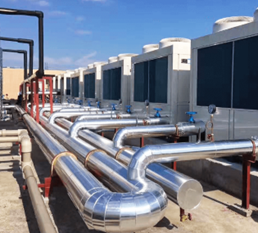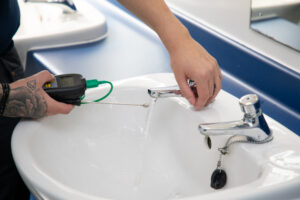Water treatment is essential in closed heating and cooling systems to avoid corrosion, bacterial growth, energy losses and damage to the system. The effectiveness of any treatment regime is reliant upon many factors including system design, usage and maintenance. Getting it right will save energy and prolong the life of the system. Getting it wrong could do more harm than doing nothing at all.
In this article we look at the causes of system degradation, things to consider when producing a closed water monitoring and treatment programme and how best to implement it.
What is a closed water system?
A closed system is one where water is circulated around a closed circuit with negligible loss. Thermal energy is transferred in or out of the system directly through a heat exchanger or through a secondary system. Over time the quality of the water in the system will degrade leading to:
- corrosion
- bacterial growth
- efficiency losses
- potential damage
It is therefore recommended that systems are kept clean and correctly treated to minimise corrosion, scale and bacterial growth, thereby maximising efficiency and prolonging the life of the system.
What are the causes of closed system degradation?
Circulation – Closed systems can be adversely affected through periods of inactivity, for example a heating system being isolated over the summer months. Adequate circulation (a minimum of one hour per day) is essential to avoid stagnation and minimise the settling of solids and the formation of biofilms.
System velocity – Closed systems need to be regularly maintained and operating within design specifications. Flow velocities are set to give the most efficient level of heat transfer for the system. If velocities are too low then solids can settle, increasing the chances of microbially induced corrosion (MIC) and biofouling. Velocities set too high can cause turbulent corrosion or physical erosion if solids are present.
Oxygen ingress – Oxygen is introduced into a closed system every time it is filled or topped up. This can be influenced by leaks or incorrect system pressures. Low pressure will draw air in through seals whereas high pressure draws in fresh water make up when the system heats up and expands. This leads to an increase in dissolved oxygen content which drives the majority of corrosion processes.
Things to consider when producing a closed water monitoring and treatment programme
An ongoing monitoring programme to assess the quality of water is the starting point to make sure systems are kept clean and appropriately treated. Those analysing a closed water system will need to know, amongst other things, the system’s volume and its material make up, such as what the boiler and pipes are made of. This will allow any subsequent analysis to be accurate and the selection of treatment to be appropriate.
How often you monitor the system will often depend on its age, design and whether issues are suspected. A detailed sampling and analysis plan should be produced and closely followed. This plan should be reviewed frequently to take into account any design or operational changes.
Implementing a closed water monitoring and treatment programme
A typical closed water monitoring and treatment programme consists of:
- collection of information on the system including the volume, metal content and current water condition
- formulation of the monitoring programme, selecting the correct inhibitor to suit the conditions identified in the initial survey and completing a biocide dose if required
- monitoring the results, identifying out of specification results and determining the appropriate corrective action
- carrying out periodic system reviews along with enhanced monitoring including laboratory analysis and assessments
- adjusting the treatment and continuing to monitor results
It is possible for those with the right skills and familiarity to take samples of water from a closed system, however it’s recommended that a specialist like IWS Water Hygiene complete the tests, interpret the findings and instigate the consequent water treatment regime.
Advice and guidance are produced by both the British Standards Institute (BSI) and the Building Services Research and Information Association (BSRIA).





